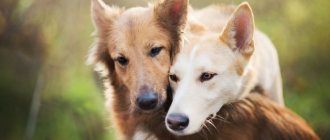Typically, a dog spends 12 to 13 hours sleeping every day. Therefore, a dog spends more than half of its life sleeping. A dog can go to sleep in a hole it has dug in the ground, on a comfortable dog bed, or on trampled grass. Dogs sleep quite sensitively. If prey or an enemy approaches, the dog will immediately wake up.
Dogs adopt different positions when sleeping, but the funniest position is when sleeping on their back. Why do dogs sleep on their backs with their paws extended up? In this position, dogs look like a table turned upside down! This pose can be interpreted as a request to scratch your belly.
Sleeping on its back allows your dog to feel comfortable because the whole body is relaxed. The position in which the dog sleeps curled up is not capable of giving such sensations, since in this position all the muscles of the body are tense.
Observations have shown that dogs sleep on their backs only when they feel completely safe, for example, in the house or on their own bed.
In the wild, dogs never sleep in this position, as they must constantly be prepared for possible dangers in the form of predators. In addition, sleeping in this position is dangerous because the throat, stomach and heart are most vulnerable in the event of an enemy attack.
Sleeping on your back is also a sign of submission. Your pet may obey you or one of your family members whom he considers higher in the hierarchy of the pack.
In this case, it is better not to touch the dog and let it sleep peacefully. Otherwise, you risk hearing a menacing growl and possibly even being bitten.
The position of a dog in a dream can tell the owner not only about its character and state of health, but also about its mood at the moment. To better understand your pet, you just have to observe its habits during its stay in the kingdom of Morpheus.
The dog sleeps on its side
This position is liked by many animals and is perfect for resting and sleeping. Lying on its side, the pet feels completely safe, and therefore is not afraid to show off its tender tummy. This means that subconsciously he is in a comfortable environment, does not worry about his vital organs and completely relaxes. The side position demonstrates the pet's strong bond with its owner and complete trust.
Paws up
On the back with paws up - a pose typical of representatives of long-legged breeds. This comical position symbolizes happiness and serenity.
It is chosen by brave dogs with a calm, independent character. They know how to stand up for themselves both in front of their relatives and in front of people, and therefore they are not afraid of anyone.
As in the previous case, the animal completely opens its internal organs and neck, which symbolizes complete trust in the owner.
Sleeping with your paws up
A rather open position, in which yard dogs never sleep, forced to constantly be on the lookout. While pets, who completely trust their owners, often fall asleep in this position, revealing their most vulnerable places when they are tired or want to cool down after a walk with active games. Dogs with long legs especially love this pose.
When getting a pet, it is important to be extremely attentive to how the animal behaves. Not being able to speak, they are sometimes quite defenseless and vulnerable, and therefore the main task of the owner is to recognize the needs and desires of their four-legged friend in time in order to provide him with the most comfortable conditions for growth and development.
Glomerulus
Pay attention to yard dogs - most often they sleep curled up in a ball. Stray animals do not feel safe and, by tucking their paws and tail, they try to protect their vital organs. In addition, in this position it is easier to stay warm in harsh street conditions.
If your pet sleeps curled up, he either distrusts you or is cold. Also, the cause may be some irritating factors: a loud TV, the sounds of repairs, the noise of household appliances. This position is often chosen by dogs with a mild, timid character.
Why do dachshunds sleep on their backs?
When a dog lies on its back, all its muscles are relaxed. This is the most comfortable sleeping position. However, it is also the most dangerous from the point of view of wild animals. In the natural environment, in this position, the most unprotected parts of the body remain vulnerable: the throat, stomach and chest. If a dog sleeps in this position, it feels comfortable. This applies to both physical and psychological state. If there is pain in the spine, the animal will prefer to sleep on its side. If the pet senses danger or sees a potential threat nearby, it will not be able to be in such an open position.
Many owners believe that sleeping on their back can be dangerous for their dog's spine. In reality this is not the case. Only those animals that already have diseases experience discomfort. Healthy companions are not in danger. Problems can only arise if the animal sleeps on an uneven surface. For example, the head and chest are on a thick, large pillow, and the rest hangs down.
You should be wary if your dachshund snores when sleeping on its back: this may indicate breathing problems.
Arranging a comfortable place to sleep can prevent injuries and the development of pathologies. In general, the general rules should be followed. The animal should not sleep near the radiator or in a draft. It is allowed to use rugs, mattresses, houses, beds with sides, etc. The type of design depends on the preferences of the pet. Some dogs like to watch what's going on, so mattresses are better for them. Other animals prefer houses because they feel safe in them. The size of the sleeping place should correspond to the dimensions of the companion. It is advisable to have a reserve so that the dachshund is not crowded. Representatives of this breed love warmth, so you can offer the dog a blanket.
Sleeping dog poses
From a physiological point of view, the postures of sleeping dogs can be divided into deep sleep poses and dozing poses, from an emotional point of view - postures of calm and stress. But sometimes, the posture of an animal can also be associated with its illness, so the dog may try to lower its body temperature or, on the contrary, to warm up.
Let's look at the most common sleeping positions in dogs, which are noted by most owners:
- Semi-sideways. Guard breeds and yard watchdogs often sleep in this position. This is due to the fact that it is easy for a dog to jump up from a position where its muzzle lies on its paws extended in front and its hind legs extended to the side. More often the dog dozes in this position; the deep sleep phase does not occur. This is not to say that this is an alarming position; most likely, the dog is simply combining business with pleasure - he is watching the territory and does not waste energy on unnecessary movements.
- On the side. The dog sleeps in this position when he really wants to get some sleep and when he is sure that he has nothing to fear. The animal in this position is completely relaxed, it feels comfortable, as it does not try to cover its organs with its limbs. Many dogs sleep in this position; it is considered the most common deep sleep position for dogs.
- Superhero seal. This position is common among puppies; in adulthood, very active dogs sleep this way. On the Internet, you have probably seen many touching photos with puppies lying on their stomachs, and at this moment their hind legs are spread out behind them, like the flippers of a seal, and their front limbs are stretched forward like Superman’s arms in flight.
The superhero seal position is anatomically comfortable and allows the dog to relax while at the same time protecting his tummy from attack. The advantage of this pose for the animal is that when waking up, the dog can quickly rise to its paws. This is a deep sleep pose.
- Sphinx. The pose exactly repeats the famous monument of ancient Egypt: the front legs are extended forward, the hind legs are tucked. Most often, dogs choose this position as an observational one, but some also doze in it. The animal is alert at this moment, ready to get up at the slightest need.
- Bagel. The pet’s body at this moment resembles a well-known baked flour product. This is not a ball yet, both in form and content. The pose is characterized by a non-closed circle formed by the dog’s body. This pose has a heat-saving functionality, and it is also a dozing pose. At this time, the dog remains on guard, ready to jump up and rush into battle if necessary.
- Fox ball. In the tangle position, a sleeping dog most often rests in cool weather. The pose is multifunctional: maintaining heat, protecting internal organs and throat, feeling comfortable. In addition to dogs, domestic foxes sleep in this position. At this moment, the animal’s body is curled into a ball, and the tail is covered by the muzzle, or the muzzle lies on its tip.
The “fox ball” position is common among smooth-haired breeds, as it reduces heat loss. The fox ball is perfect for dogs for deep sleep; most often this is how the dog goes to sleep at night.
- On the back. The pose of a completely relaxed animal, who is not afraid of anything in his life and feels extremely confident. During rest, a sleeping dog lies on its back, and its paws can be either bent at the joints or extended upward, which is quite funny. In this position, the dog most often sleeps deeply.
- Faithful knight. The pose of a dog that is allowed to sleep in its owner's bed. The animal stretches out to its full length and presses against the owner. This is how the dog shows that, firstly, it wants to protect its owner, and secondly, to warm him up. This can be done by both a small sheltie and a huge mastiff. The advantage is that this is typical only for very devoted dogs who dote on their owner and are ready to warm him all night. The downside is obvious - you sleep with a dog.
Why does a dog spin around before lying down?
Normal behavior. In nature, the ancestors of domestic dogs were forced to walk in circles before lying down. This is necessary in order to trample snow, leaves, branches, etc. So, the instinct to make a circular motion before lying down is quite normal.
Likewise, it is normal for a dog to want to dig a hole for itself at night. Many owners of small dogs are annoyed by this desire of their charges, since the dog sleeps with the owner on his bed and has every chance of digging a hole in the bed linen.
Annoying or not, the urge to dig a hole and roll around before bed is natural for a dog of any breed and any size.
Cause for concern. The reason to contact a veterinarian is if your dog walks in circles for too long. Normally there should be only a few circles. If there are a lot of them, and the dog cannot lie down, it means that something is bothering him. This is usually either arthritis or neurological problems.
"Superman"
Many pets enjoy sleeping on their stomachs, but this position is especially cute. All four limbs are extended, and the head lies so that it’s difficult for them to fly somewhere. This position allows the dog to quickly jump up to its paws if you call them. Such animals are often energetic and easy to train.
A nutritionist gave advice on restoring nutrition after the holidays
“Bright, beautiful girl”: Lyubov Uspenskaya made peace with her daughter
Users have spent almost 11.5 million years watching gaming content: YouTube
Fox position
The curled up position is probably the most common. The animal hides its legs under its body and covers its muzzle with its tail in order to retain heat as much as possible.
Add new foods gradually: how to eat properly after fasting
Exquisite fish and side dish at the same time: dorado on a potato bed for Christmas
Elon Musk added his favorite game The Battle of Polytopia to Tesla
Dogs sleeping in this position are easy to train, have a gentle temperament, and tend to be sweet and passive.
Interesting Facts About Your Dog's Sleep
Contents hide
Interesting Facts About Your Dog's Sleep
All people are different. And they also sleep differently - each one is used to it and loves it. And there is no point in listing possible habits and inclinations! At least look at yourself and your household, and you will immediately understand everything. Tell me, why are dogs worse? Each animal also has its own individual preferences!
When. It all depends on your lifestyle and level of physical activity. I took a walk, did plenty of exercise in the fresh air, ate a hearty meal - and you can take a nap. Then go for a walk again, etc. Dogs, if necessary, can remain active throughout the day - for example, while hunting. Then they will definitely plunge into the arms of Morpheus and sleep for at least a whole day. What's in the wild? I got food, ate, slept, and again I had to go get food. There is no such thing as a walk for wild or stray dogs! How does your four-legged friend sleep and stay awake? Does he have problems sleeping or does something need to be corrected?
Where. The dog will always settle down to sleep where it is comfortable and comfortable. In the wild, the leaders of dog packs choose high places so that it is convenient to observe what is happening around them. At home, dogs also love “high places” - beds, armchairs and sofas. Thus, they make a claim for their own exclusivity. Sometimes dogs choose the warmest place to sleep - usually in winter. In summer, on the contrary, they will settle down where it is cooler. Some animals prefer hard surfaces, others like to sleep where it is soft. One thing is required from you - determine a place for the dog where it can sleep. That is, her own place; what exactly it will be does not really matter. It is not necessary to buy anything; it is enough to make do with your own funds. The dog will soon let you know about its preferences, and you “catch”, do not miss the signals. Some animals love to rummage around in their house or place before going to bed - natural instincts take effect. Dogs can tear all their blankets and other bedding to shreds. This usually happens when you are constantly away from home, and the animal experiences separation acutely.
How. Sleeping positions also vary depending on the preferences of a particular dog. Someone sleeps neatly, curled up. Some lie on their backs, others limply spread their paws, moreover, dangle them in the air! Sometimes animals choose, in our opinion, completely uncomfortable positions. But there is no need to worry: if the dog sleeps serenely and deeply, then everything is in perfect order. The main thing is to follow the wise proverb and not wake up sleeping dogs. They can throw this out of sleep! Just like many of us. It happens that dogs suddenly wake up for no apparent reason. You shouldn’t be surprised - dogs’ sense of smell and hearing are much better developed than people’s. You never know what they'll smell!
Dreams. It is believed that dogs dream. At these moments, our pets twitch, shudder, roll their eyes, growl and even bark. Out of habit, you can even get scared, but know that this behavior is the norm. By the way, many dogs are distinguished by their heroic snoring; and it is not at all necessary that dogs of exclusively brachycephalic breeds snore. Everyone can snore!
What changes with age. Young puppies tend to sleep more than they are awake. The older a dog gets, the less time it needs to sleep. Dogs have the ability to fall asleep almost instantly, especially when they are tired and exhausted. Many adult dogs sleep soundly throughout the night. It is better to prepare your pet for this regime in advance, from a very young age. Do not pet the puppy, do not accustom him to your hands, and under no circumstances put him in bed with you! Be methodical and consistent, but be sure to teach your baby to sleep alone. The main recipe is patience and work, and everything will gradually improve.
Older dogs also sleep an order of magnitude more. Additional care will be required on your part. Often, older dogs suffer from age-related diseases - arthritis, aching bones and joints. Try to keep the animal warm and soft to sleep. Perhaps create a separate quiet corner in the house, especially if you have noisy children, etc. Quite often, older dogs experience hearing loss. Such pets usually sleep well, but may feel frightened immediately after waking up.
Sleep disorders. The main principle remains the same and unchanged: never wake a sleeping dog. Don't disturb her peace! This is a guarantee that the animal will sleep peacefully and deeply throughout the night.
But then the dog woke up. If you wake up with her and make contact, you will most likely reinforce this habit. Probably the animal just wanted to go to the toilet. When you live in your own home, the situation is simplified - all you have to do is let it out into the street without making eye contact with the dog. But if night trips to the toilet become the norm, then the situation will have to be analyzed thoroughly. It may be necessary to make serious adjustments to your daily routine and diet.
Try not to fixate your attention on the dog at night for as long as possible. Always remain calm. Pretend that you are more interested in your own affairs. You can open the door indifferently, as if inviting the dog to come out. If she really needs it, she will give a signal. It will simply invite you to action by wagging its tail - then ignore your pet. Go to the kitchen, drink a glass of water, and calmly return back to the bedroom. This technique actually works - the dog will clearly understand that everything is in order in the house, the owner is calm, nothing extraordinary has happened. Most likely, your pet will soon calm down and fall asleep again.
Dogs can behave restlessly at night, when they are tormented by attacks of pain, during periods of exacerbation of chronic diseases. If you have the slightest suspicion of a deterioration in your pet's health, contact your veterinarian.
Original publication: Dogs And Sleep. Source and photo:
How to tell if your dog is in pain
Author Irina Gusakova
27.09.2019 15:36
Zoosphere » Dogs
Unfortunately, a dog cannot tell you if it is in pain. In some cases, it is obvious that the animal is in pain when it has an open wound, a visible injury, or when the animal is limping. But in some cases, the damage may be invisible, but cause suffering to the dog.
On top of that, dogs react to pain differently. Some will show obvious signs of malaise, whine, seek help from a person, while others will stoically endure. Dog owners must be extremely alert and observant to spot and recognize signs of pain in their dog.
Your dog has ways of showing you that he is not feeling well. One of the first signs will be a change in behavior. A normally calm dog may become aggressive and may even try to bite its owner when he pets or examines it, especially if his hand gets close to the painful area. The most peaceful dog can show aggression if it feels severe pain. If you suspect an animal is in distress, examine it with caution. It is best to muzzle your dog before the examination. The dog may become furious or uncontrollable in pain, have difficulty sleeping, or growl, bark, howl, or whine for no apparent reason.










